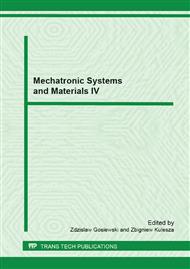p.382
p.388
p.394
p.400
p.406
p.412
p.421
p.427
p.433
Simulation Model of an Electromagnetic Multi-Coil Launcher for Micro Aerial Vehicles
Abstract:
The paper presents a model of the 10-coil launcher, which can be used as a catapult of micro aerial vehicles (MAVs). The main advantage of such a device is the possibility of controlling its acceleration. We have also shortly described main disadvantages of pneumatic and rubber launchers and compared them to our solution which involved magnetic phenomena. The history and the classification of magnetic launchers were also mentioned. The investigated magnetic system was described in details. The system voltage equations and energetic conversions which take place during the launch were presented. With the use of finite element method we calculated the lumped parameters of the system (self-and mutual inductances). Nonlinear model was implemented in the MATLAB packet. Launch operation was divided into an acceleration and a braking phase. Thus, nine coils operated as accelerators and the last one was employed as a magnetic brake. The system was controlled by means of PID regulators which were tuned manually. Current values in the modelled coils were also limited by bang-bang controllers. In the last part of the paper we presented results of simulations and discussion about possible improvements of the model in the future.
Info:
Periodical:
Pages:
406-411
Citation:
Online since:
March 2013
Authors:
Price:
Сopyright:
© 2013 Trans Tech Publications Ltd. All Rights Reserved
Share:
Citation:


